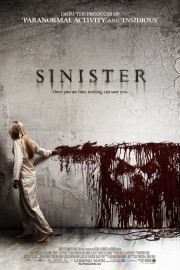Sinister
I don’t really know why I’ve begun to warm up to the horror genre the past few years. I guess there’s just something about being scared that gets to me. And Lord help me why I’ve become so enticed by movies where things come out of the dark to scare us; that was always a phobia of mine, of sorts, over the years. I’ve since gotten over it, but that doesn’t mean I’ve lost my ability to be scared by what could come out of darkness.
Scott Derrickson’s “Sinister,” which he co-wrote with C. Robert Cargill, got under my skin big time in that respect. I’m not sure if I want to put it on par with “The Shining,” “Insidious,” or “The Blair Witch Project” among great “gotcha” horror movies, but this DID freak me the fuck out. (Pardon the language, but hopefully, no children are reading a review for this movie anyway.)
The movie begins with an 8mm film of a family of four hanging from a tree. A limb breaks, and the rope tightens around their necks. They struggle for a bit, but eventually, they stop moving, and the film breaks. This is what true-crime author Ellison Oswalt (Ethan Hawke) watches shortly after moving into the same house where the tragedy took place, along with four other, horrifying homemade films. In each case, dating back to 1966, a child went missing. At first, each incident seems isolated, until a ghoulish face is seen in the background. But the deeper Ellison gets into the cases, the more unusual, and dangerous, things get for his family.
Derrickson previously directed “The Exorcism of Emily Rose,” which was a favorite among genre fans who liked the interesting spins he put on that well-worn sub-genre. In this film, he’s even more in control of his film’s narrative conventions, and even more capable of toying with the audience’s expectations. The use of the 8mm film, and the use of video in general, is inspired, in particular because it adds another level of mystery to the proceedings. Who made the films? Who left the films for Ellison to find in the ceiling? And more importantly, what happened to the children who went missing? Perhaps a college professor (Vincent D’Onofrio) who specializes in the occult has some answers; the local sheriff (Fred Thompson) is not really too keen on helping out– he just wants Ellison to leave town.
This is one of those movies where I hate to spoil things in a review, because it’s those things that make the film so memorably creepy. The shots of the missing children during one late-night investigative session. Ellison’s son, Trevor’s, night terrors, which get particularly troubling after moving into the house. His daughter’s penchant for painting on the walls, and one, in particular, that leads to disturbing revelations. From a technical standpoint, the symbiosis of the cinematography, editing, sound design, and music (the latter by Christopher Young) creates the most unsettling haunted house since the Overlook Hotel in Kubrick’s “The Shining.” At the center of it all is Hawke, who anchors the proceedings with his typical intelligence, and atypical leading man appeal. He keeps us riveted by this sinister thriller every step of the way.










